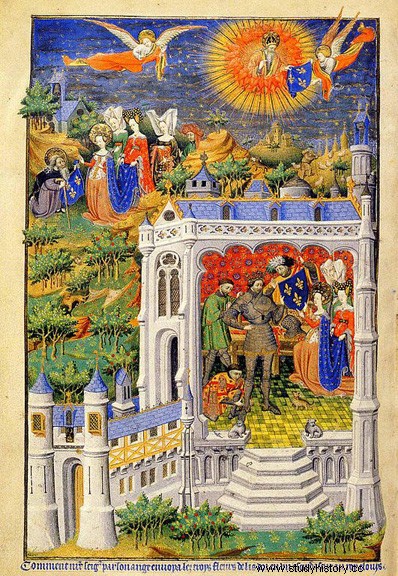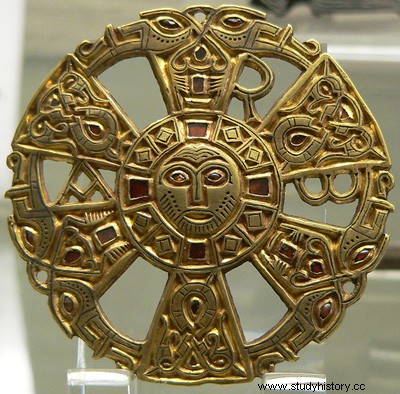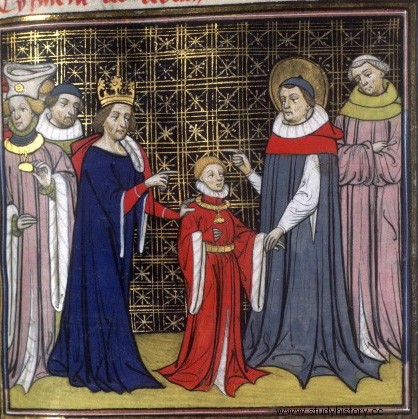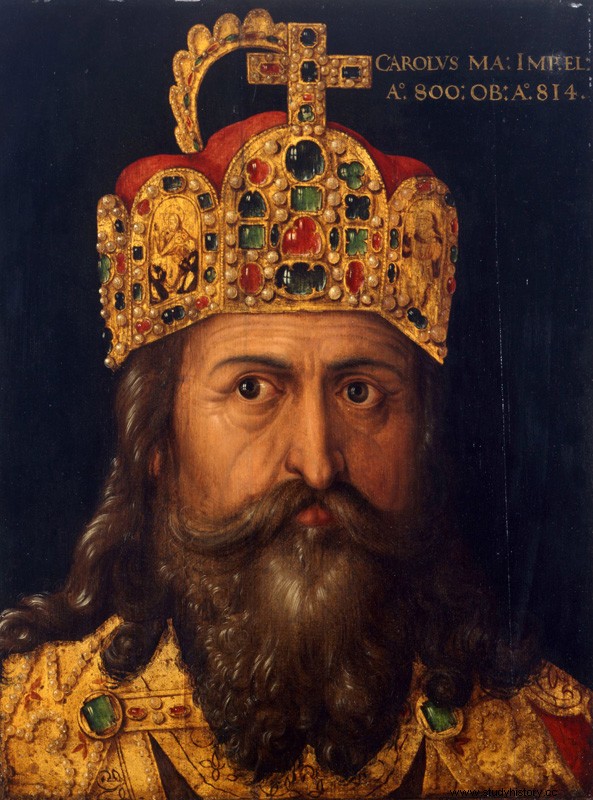
Origin of the people and the word “Franc”:
The word “Frank” comes from frekkr which means “bold”, “courageous”. It was in the middle of the 3rd century, in a war song of the Roman army, that the name Franks appeared in history:“We have killed thousands of Franks!”. Thanks to the troubles at the end of the 3rd and 4th centuries, the Franks carried out raids on Roman soil. Then they settle on the border of the Empire, which they undertake to defend in exchange for land to cultivate. From 407, they took advantage of the weakening of the defenses of the Roman Empire to progress westward and settle on Roman lands.
CIRCA 450:The Franks are divided into 2 large groups
On the one hand the Rhenish Franks, settled on the Rhine, and on the other hand the Salian Franks who progress towards the valley of the Somme. They are divided into multiple kingdoms, including that of Childeric, who became a Roman general and head of the Roman authorities. Installed in the region of Tournai, he relied on the military force of the Frankish barbarians to maintain power on the borders of the Empire. The family of the latter is given the name of “Mérovingiens” in homage to King Mérovée, the more or less mythical ancestor of the dynasty.

TOWARDS 466:Birth of Clovis
Clovis comes into the world while the Western Roman Empire lives its last years.
EN 482:Clovis becomes king of the Franks
He succeeds his father Childeric I and while the latter defended the Romans against the Visigoths, he fiercely opposed them. His reign marks a decisive stage in Western history. He creates the greatest barbarian kingdom and he established a dynasty that lasted 300 years.
The Soissons vase:
Clovis moved to Soissons after having attacked the last center of Roman authority which was there. He wants to subtract from the booty a magnificent church vase for the benefit of the bishop who claimed it from him. Furious at this departure from the customs of war, which advocates fair sharing, one of the soldiers preferred to break the vase rather than give it to his king. Clovis took revenge the following year by killing the soldier with an axe.
CIRCA 496:Clovis marries Clotilde
Clotilde is the niece of King Burgonde (Germanic people) Gondebaud and she is a very fervent Christian .

DECEMBER 25, 498:Clovis was baptized in Reims
It is reported that Clovis vowed to convert to Christianity if Jesus Christ granted him victory against the Alamanni. Having been answered, Clovis agreed to follow the teaching of Archbishop Remi. The baptism was celebrated with great pomp throughout the city and 3,000 Frankish soldiers were also baptized on the same day. Clovis became the one by whom Catholicism was confirmed as the dominant religion in the West. At that date, he was the only Catholic sovereign in the West and he received the support of the Church, not only in his Kingdom, but also in all the other Barbarian Kingdoms. Thanks to the unfailing support of the clergy, he continued his enterprise of territorial expansion of the kingdom of the Franks. He presides over the fusion between the Gallo-Roman world , the Frankish world and the Germanic peoples . From the middle of the 6th century, the term “Franc” designated all the subjects of the king.

CIRCA 500:Frankish Kingdom of France and Germany
Clovis continues the Frankish conquests until unifying almost all of Gaul (from the Rhine Valley to the Pyrenees):He drove back the Alemanni beyond the Rhine, crushes the Visigoths at Vouillé (near Poitiers), eliminates the other Salian Frankish kings (his relatives) in the Somme valley and imposes his authority on the Franks of the Rhine. Then he moved to Paris * which becomes the capital of his kingdom.
Frankish culture:
With the conquests of Clovis , the Frankish culture took root in Gaul , in particular between the Rhine and the Seine. The Frankish style, of Germanic origin, reveals Byzantine influences , particularly in goldsmithery decorations. The choice of Paris as capital contributes to forging an original Frankish culture that integrates the Roman and Gallo-Roman heritage.
NOVEMBER 27, 511:Death of Clovis
On his death, his 4 sons shared his inheritance and continued the Frankish conquest. The kingdom of the Franks becomes the main power in Western and Central Europe. The Franks allied with the Byzantines against the Ostrogoths , then against the Lombards , but remains however torn by the quarrels of the sons of Clovis , then son of Clotaire I . The years of conflict accentuate the particularism of the various regions that make up the Kingdom:Neustria (North-West Gaul), Burgundy, Austrasia (Eastern Region) and Aquitaine.

FROM 623 TO 639:Reign of the King of the Franks Dagobert I
Clotaire II names his son Dagobert King of Austrasia (Eastern Region). Dagobert settles in Metz, and on the death of his father, he seizes Burgundy and Neustria. He entrusted Aquitaine to his half-brother Caribert, and when the latter died in 632, Dagobert becomes the sole master of the Empire of the Franks and settles in Neustria. He imposes his royal authority, removes several threats and pushes the borders of the Kingdom to the Elbe. He initiates sons of the high aristocracy to the power and administration of the Kingdom so that they assume responsibilities in their provinces. Thus, Éloi , Didier and Ouen respectively become bishops from Noyon-Tournai, Cahors and Rouen. It is the Churches, through the person of the bishop, who hold power and authority in the cities of the kingdom of the Franks. Saint Eloi was Dagobert's main adviser and it is in this capacity that he entered the legend and the song .
FROM 639 TO 843:Decline of the Merovingian dynasty
The Kingdom of the Franks is fragile because the fights between lords are permanent and the members of the high aristocracy become more and more demanding. Sovereigns squander their heritage and impoverish themselves in exchange for their loyalty. On the death of Dagobert in 639, his eldest son Sigebert III retained Austrasia, while Clovis II becomes king of the Franks at the age of 4 years old and receives Neustria and Burgundy. The child-kings following govern only a few years and attend powerless to the conflicts dividing the aristocracies. These became real stewards of the kingdoms of the Franks and contributed to the weakening of the power of the sovereigns. The last Merovingian kings are nothing more than "lazy kings" without power or fortune, who circulate between the last plots of their domains to find enough to meet their needs. It is because he leaves this context, to mark his ultimate success and his golden age, that the nickname “good king Dagobert ” appeared in 1750.

EN 732:Charles Martel repels the Umayyad Muslims
The Arab horsemen, reinforced by the Berbers , carry out devastating raids all along the roads of Aquitaine. But they are stopped in their progress by the troops of Charles Martel . His victory is decisive for the West and for France , but it in no way detracts from the prestige of Muslim civilization, which is experiencing a veritable golden age.
Between 714 and 768:Reign of Pepin III, known as Pepin the Short
He is the son of Charles Martel and he was the first monarch of the Carolingian dynasty .
In 768:Charlemagne becomes king of the Franks
On the death of his father Pépin le Bref , the young prince Charles is crowned King of the Franks . He is called Charlemagne (Carolus magnus) or Charles the Great. He inherited most of what was then France.
Between 773 and 804:Charlemagne builds a large empire
Charlemagne is a distinguished soldier and a devout Christian. In 30 years, he annexed new territories and created a Christian empire as vast as the Roman Empire once was. He pays to erect churches and monasteries throughout his Empire and orders non-Christian populations to join the Church. He encourages scholars, artists and artisans to come and work in Aachen, the city where he resides in his palace.

In 800:Coronation of Charlemagne
Charlemagne is crowned “Emperor of the Romans ” by Pope Leo III.
In 814:Death of Charlemagne
Death from Charlemagne to Aachen.
Between 841 and 853:Charlemagne's empire was divided into 3 kingdoms
Each kingdom is ruled by a member of the Carolingian family. The Carolingian Empire seems to triumph, yet the 3 kings constantly clash for the division of the Empire. They do not take into account the threats posed by the Viking pirates and their kingdoms gradually decline.
Indeed, the Vikings disembark aboard their frightening longships to settle permanently in Rouen, Nantes, Paris, Tours.
In 887:Eudes defends Paris from the Vikings
Eudes, Count of Paris, defends the city against the Norman Vikings:
Eudes was then elected King of the Franks. It was finally famine that temporarily drove out the Vikings in 892.
In 900:The 3 kingdoms inherited from the empire of Charlemagne are in danger
The Vikings invaded the Western Kingdom and the Central Kingdom. Tribes of Magyars (present-day Hungary) attack the eastern kingdom.
*Note on Paris :It was around 357-366 that the city took the name of Paris.
